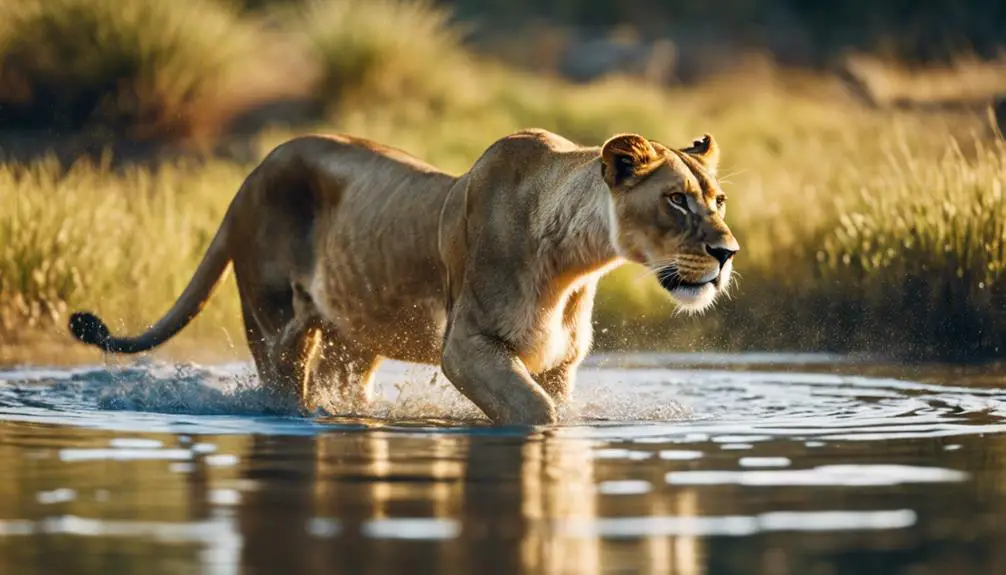Lions can swim, although not as proficiently as tigers or jaguars due to their limited interactions with water. They may venture into water to cross to the other side or when pursuing prey. Lions utilize water to regulate body temperature, cool off in the savanna heat, hydrate, and strategize hunts. Their adaptations, such as partially webbed toes and buoyancy from thick fur, aid in swimming efficiency. Lions’ intriguing relationship with water showcases their adaptability and survival skills in the diverse savanna landscape. Further insights into lions’ aquatic behaviors and adaptations await.
Lions Swimming Abilities

Lions may not be as skilled at swimming as tigers and jaguars due to their infrequent practice in the water. Unlike jaguars and tigers, who regularly swim and hunt aquatic prey, lions are primarily terrestrial animals that prefer land over water. This lack of consistent swimming practice leads to lions having lesser swimming abilities compared to their feline counterparts.
While lions do enter water for specific reasons, such as cooling off, relaxing muscles, and hunting prey like wild hogs and zebras, their swimming skills aren’t as refined. Jaguars and tigers, on the other hand, are more adept swimmers due to their frequent interactions with water. Despite this, lions can still navigate through water, especially when necessary to reach the other side of the land or when chasing prey.
Reasons for Lions Entering Water

To cool off and relax muscles, lions often enter water, utilizing it to regulate their body temperature during the peak heat of the savanna from May to July. The savanna temperatures can soar during these months, making it essential for lions to find ways to cool down.
By spending hours in water, lions not only hydrate themselves but also effectively manage their body temperature in the scorching heat. Additionally, water serves as a strategic element for lions when hunting prey such as wild hogs, buffalos, and zebras.
Lions may jump into the water to catch prey, ensuring a successful hunt and a meal for the pride. Therefore, while lions may not be as skilled at swimming as other big cats, they capitalize on water as a resourceful tool for survival in the savanna environment, especially during the hottest months of the year.
Lions Hydration and Temperature Regulation

Venturing into water not only helps lions cool off and relax their muscles but also plays an important role in regulating their body temperature, especially during the scorching heat of the savanna’s peak months from May to July. Lions hydrate themselves by spending hours in the water, aiding in maintaining their body temperature during hot periods. This behavior is essential for their survival in the harsh African climate.
Additionally, water serves as a source of hydration for lions, ensuring they remain healthy and active. By immersing themselves in water, lions can replenish lost fluids and prevent dehydration in the arid savanna landscape. The ability to regulate body temperature through water activities is crucial for lions to thrive in their natural habitat.
Lions Hunting Behavior in Water

Immersing themselves in the water, lions exhibit unique hunting strategies to secure prey and guarantee the pride’s sustenance. While not as adept swimmers as tigers and jaguars, lions enter water for specific purposes, such as cooling off, relaxing muscles, and hydrating during peak temperatures in the savanna.
Lions often venture into water when hunting favorite prey like wild hogs, buffalos, and zebras. They may even jump in to catch their prey if necessary, using swimming as a tactic to assure a successful hunt and secure a meal for the pride. Additionally, lions use water for navigation, swimming to reach the other side of the land when needed.
This behavior showcases their adaptability and resourcefulness in utilizing their surroundings for survival. By incorporating water into their hunting strategies, lions demonstrate their ability to thrive in diverse environments and confirm the pride’s continued well-being.
Lions Adaptations for Aquatic Environments

While lions may not be as proficient swimmers as tigers and jaguars, they’ve developed adaptations that allow them to navigate aquatic environments efficiently. Lions possess partially webbed toes that aid in swimming and provide better traction in muddy areas, helping them move through water more effectively.
Their muscular bodies enable them to stay afloat and swim short distances when necessary, such as crossing rivers to reach new hunting grounds or escape threats.
Additionally, lions have a unique ability to regulate their body temperature, which comes in handy when they spend time in water to cool off during hot periods in the savanna. Their thick fur repels water, preventing them from becoming waterlogged and aiding in buoyancy.
Lions’ adaptations for aquatic environments showcase their versatile nature and their ability to adapt to different terrains when required.
Lions Interaction With Water Ecosystems

In water ecosystems, lions play a significant role in maintaining the balance of their habitats through their interactions with various aquatic species. Lions’ presence near water sources influences the behavior of aquatic animals like crocodiles, hippos, and fish. Their occasional forays into rivers or lakes impact the local ecosystem dynamics by creating ripples of change. While lions primarily rely on terrestrial hunting, their interaction with water ecosystems showcases their adaptability and versatility in exploring different environments. Lions may even scavenge on fish or other aquatic creatures, showcasing their opportunistic nature.
Furthermore, lions’ interactions with water ecosystems can also affect plant life along riverbanks or lakeshores. Their movements near water sources can inadvertently spread seeds or disturb vegetation, contributing to the overall biodiversity of the area. By understanding how lions interact with water ecosystems, researchers can gain insight into the intricate connections between terrestrial and aquatic environments in the wild.

Erzsebet Frey (Eli Frey) is an ecologist and online entrepreneur with a Master of Science in Ecology from the University of Belgrade. Originally from Serbia, she has lived in Sri Lanka since 2017. Eli has worked internationally in countries like Oman, Brazil, Germany, and Sri Lanka. In 2018, she expanded into SEO and blogging, completing courses from UC Davis and Edinburgh. Eli has founded multiple websites focused on biology, ecology, environmental science, sustainable and simple living, and outdoor activities. She enjoys creating nature and simple living videos on YouTube and participates in speleology, diving, and hiking.


